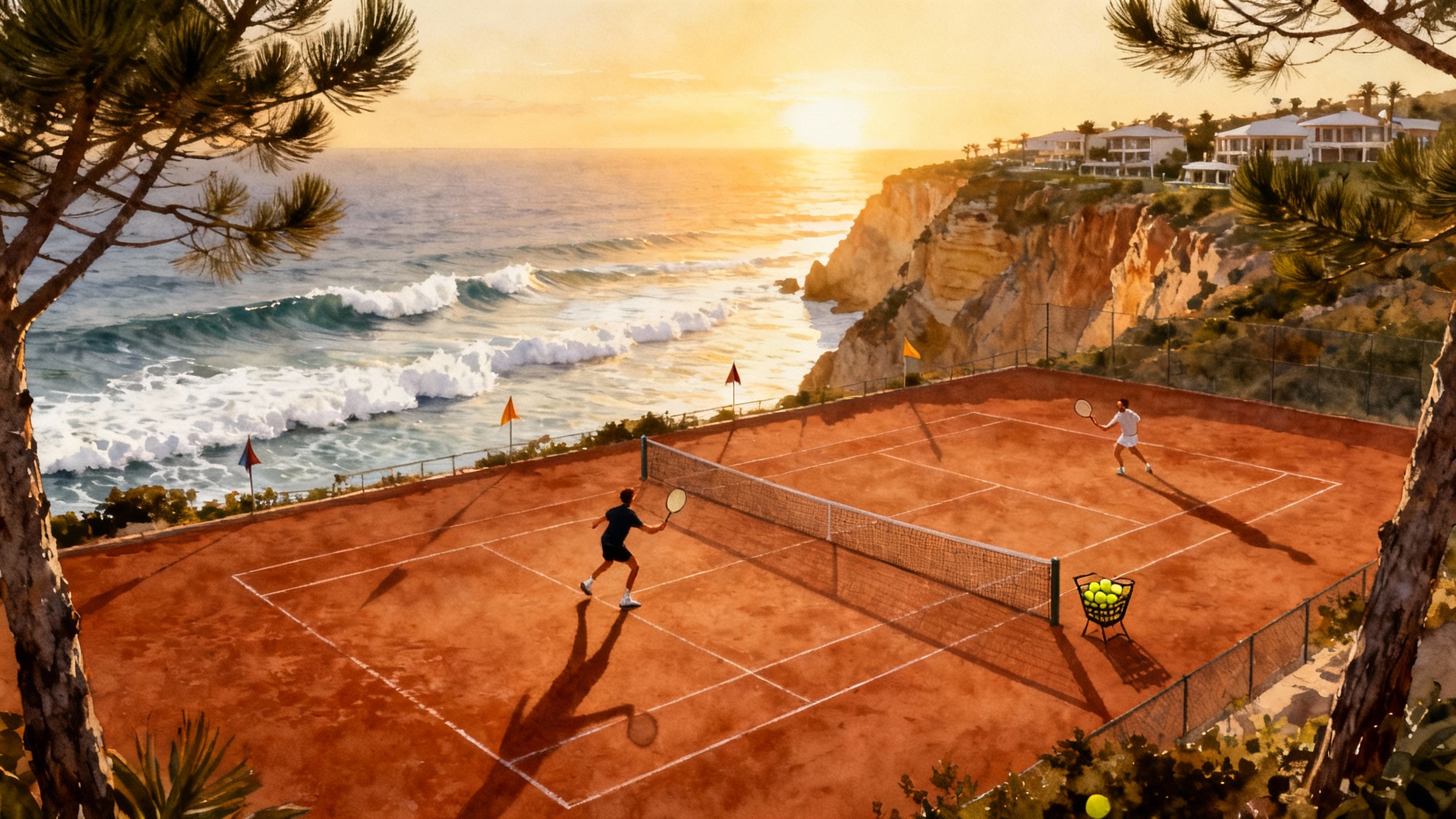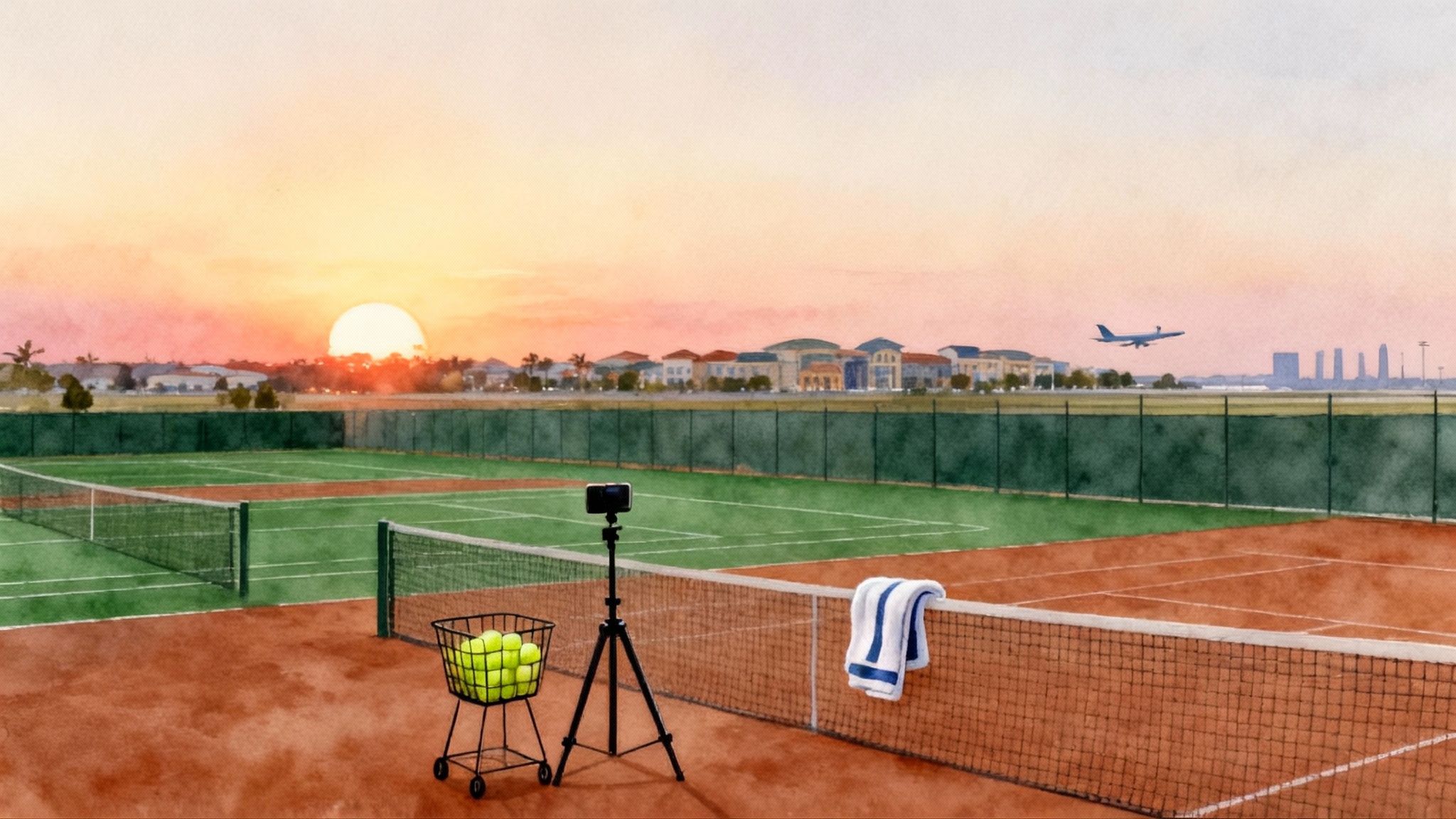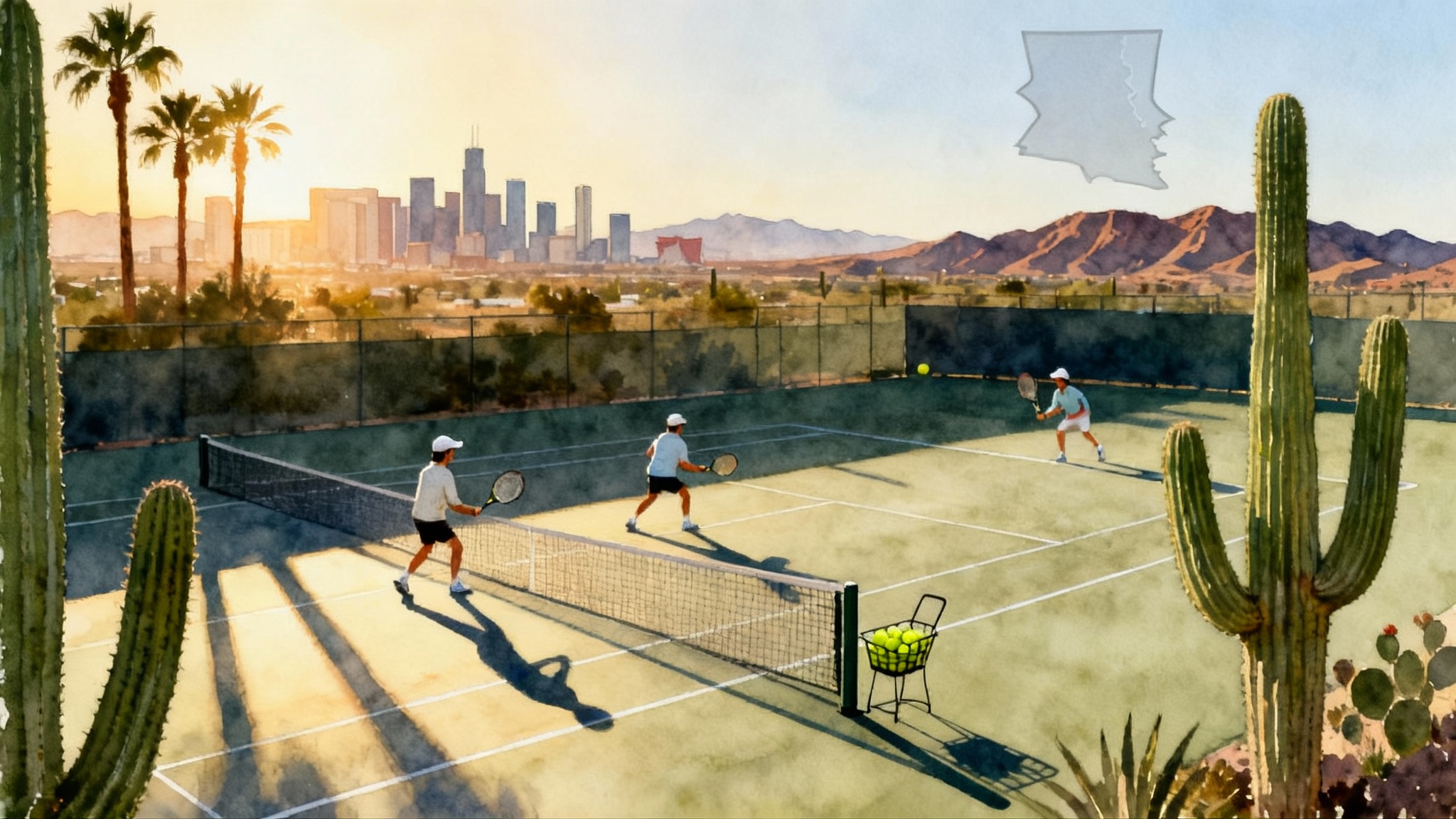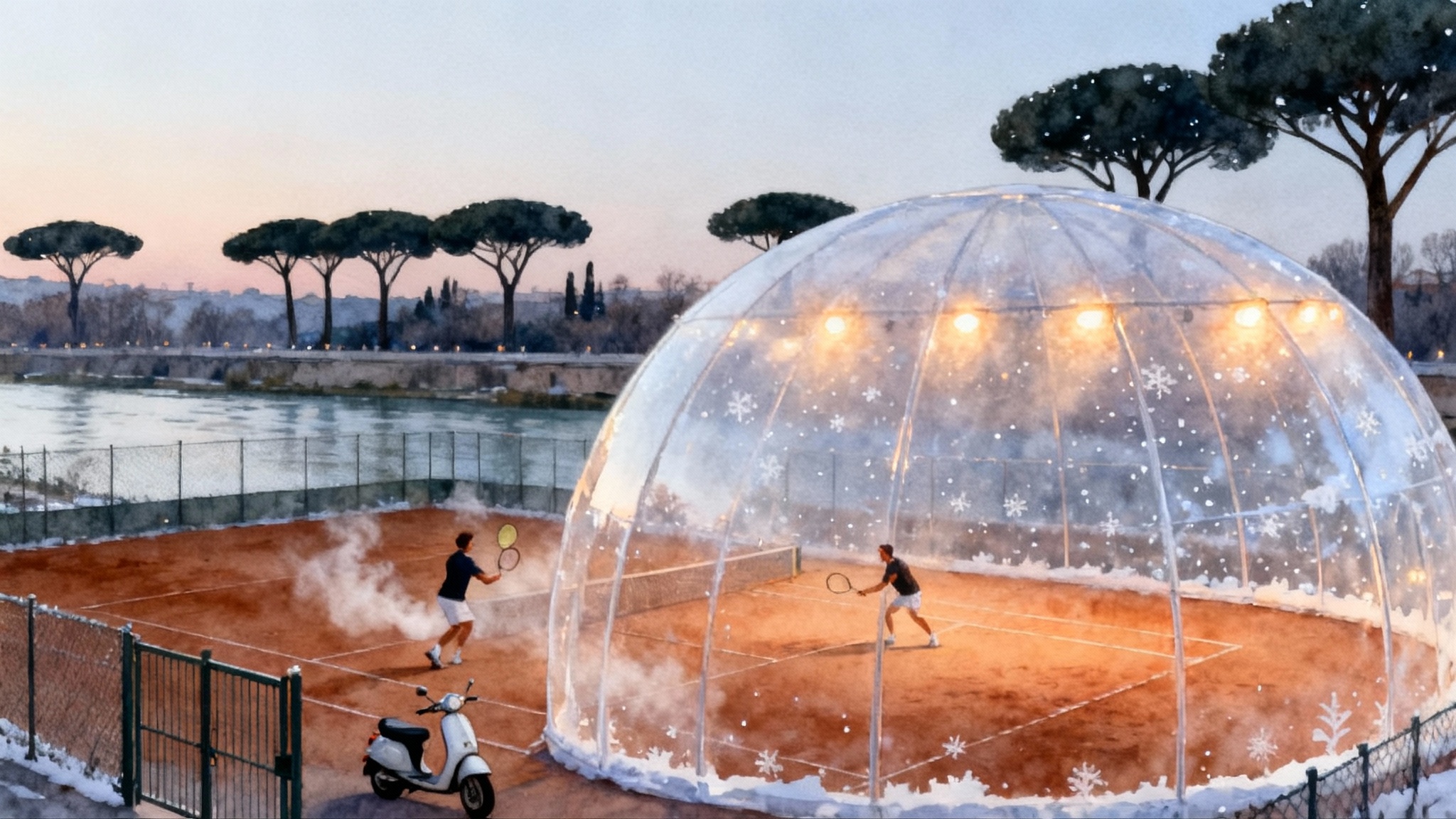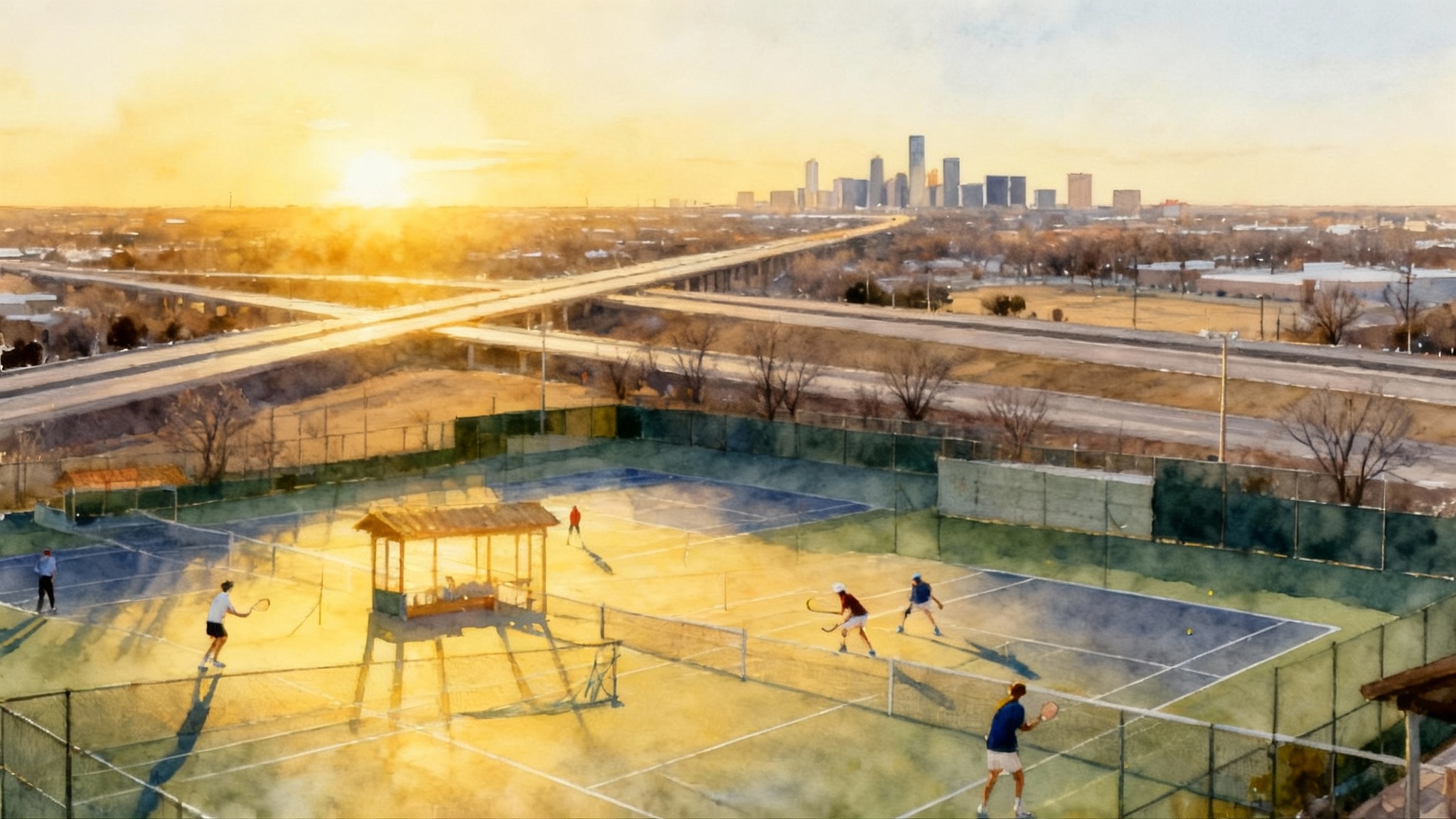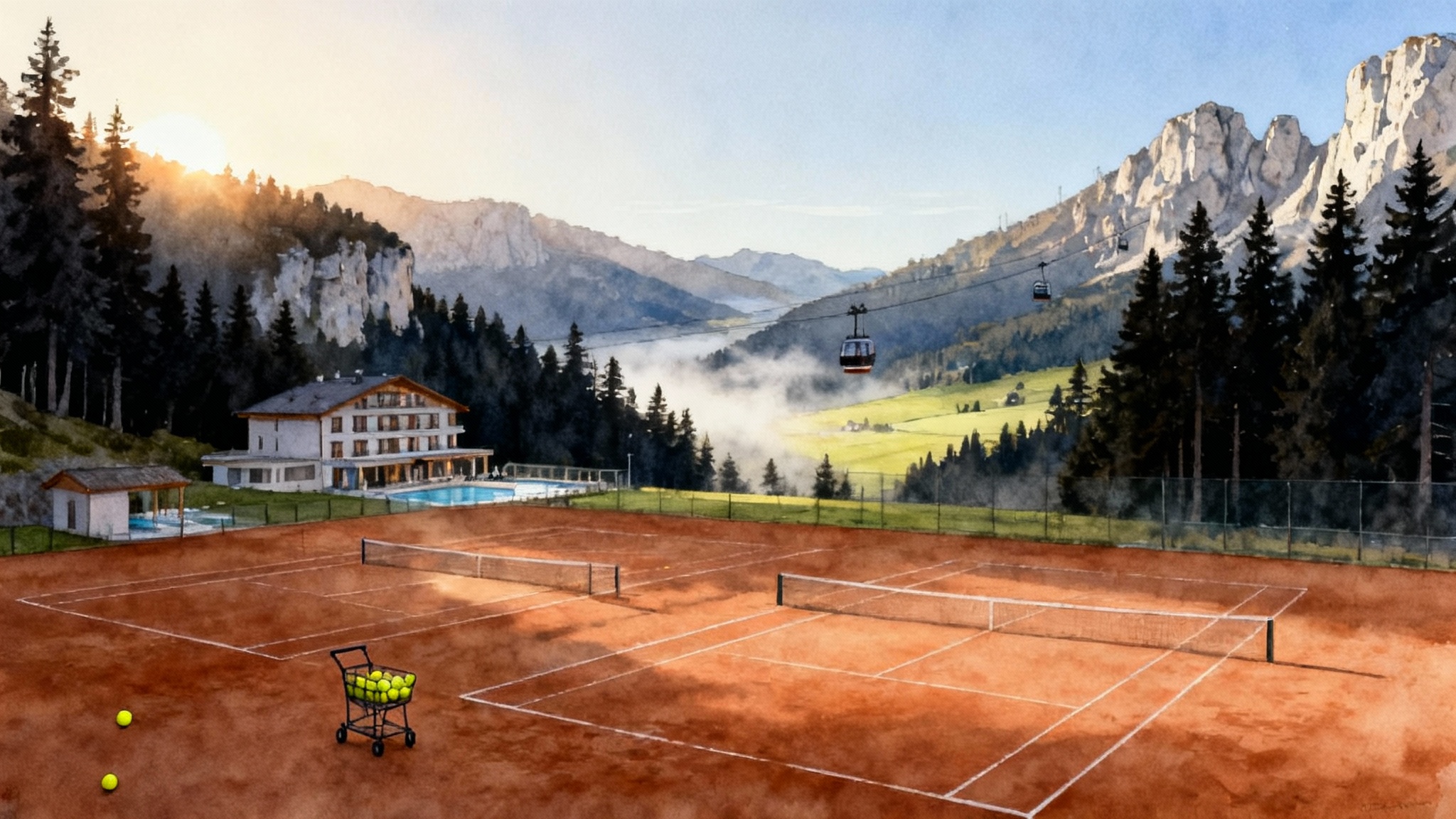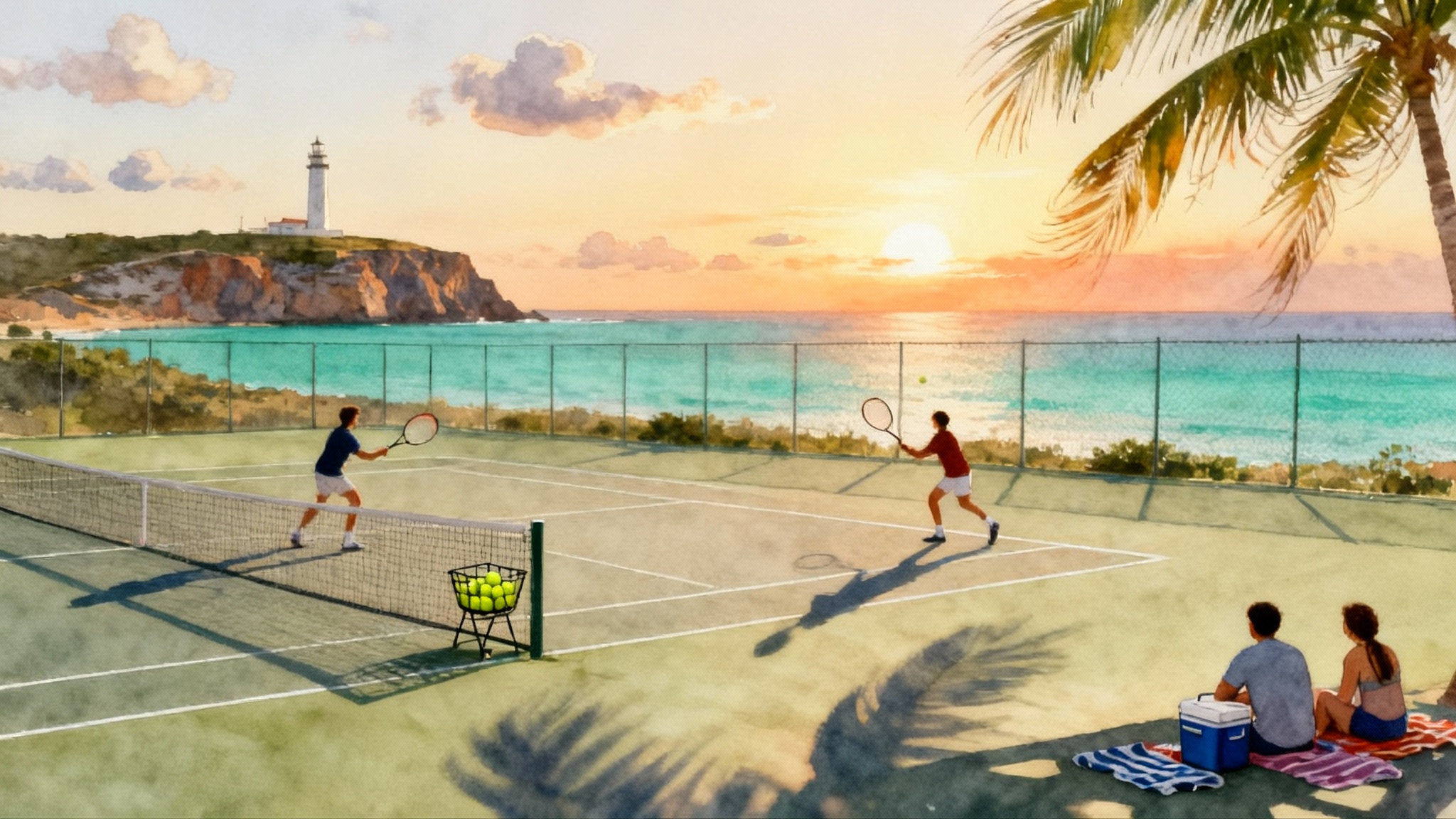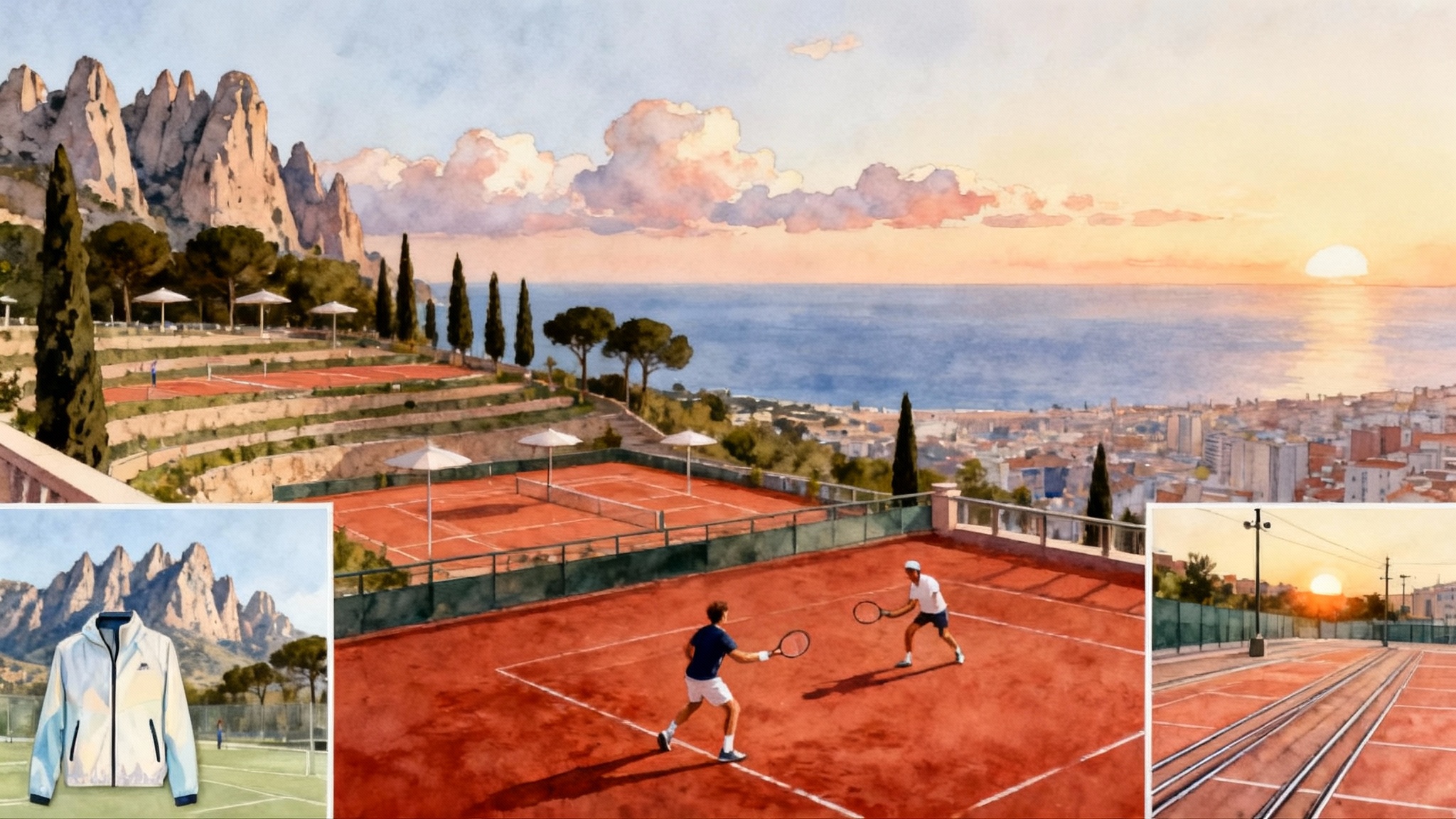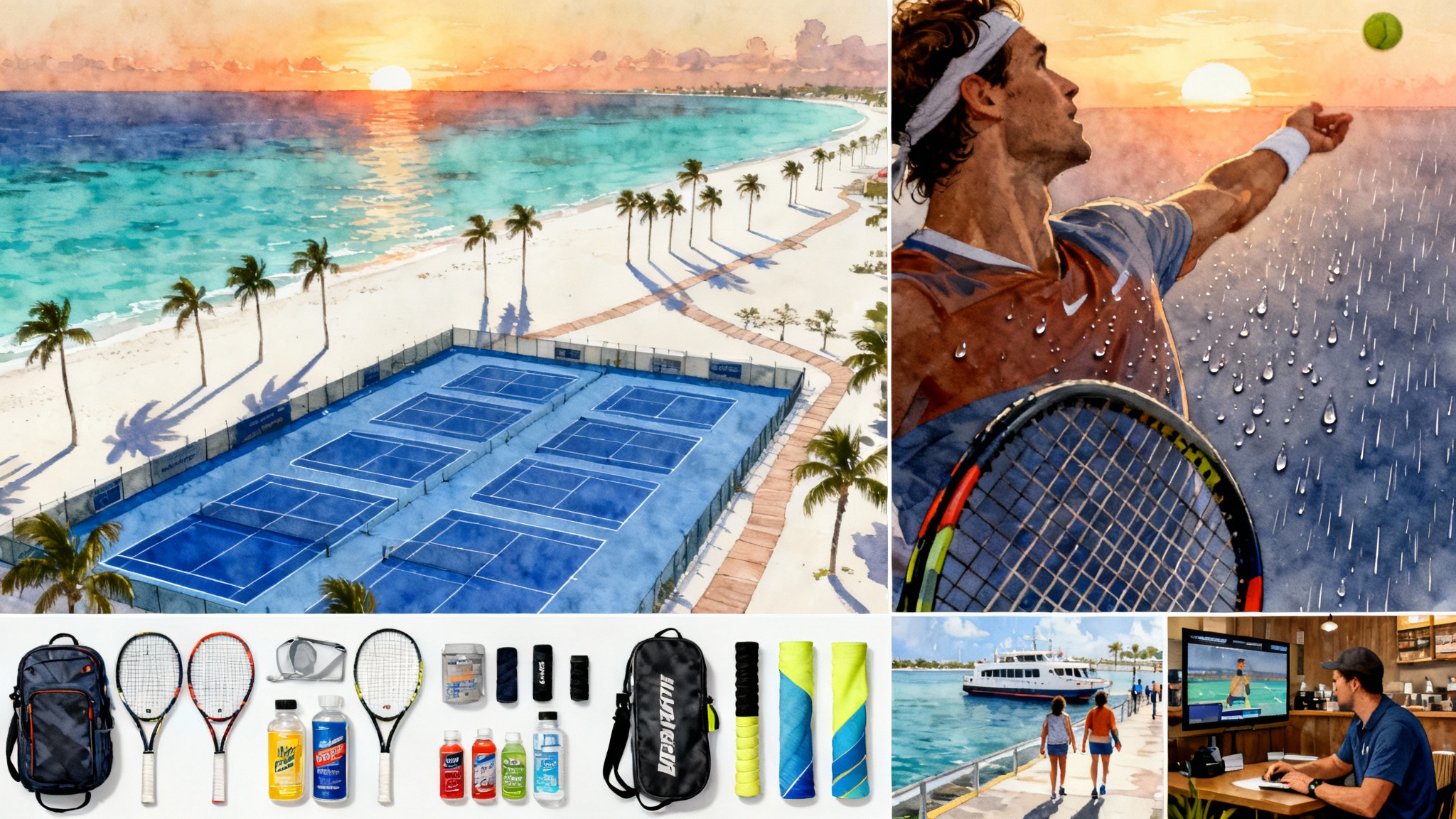Bangkok Tennis: Build a 2–4 Week Nov–Feb Dry Season Block
Use Bangkok’s cool, dry months to run a 2–4 week training block. Plan early and late sessions, mix covered courts with outdoor heat adaptation, plug into Troops Tennis Academy, and add Hua Hin, Chiang Mai, or Phuket for competition and recovery.
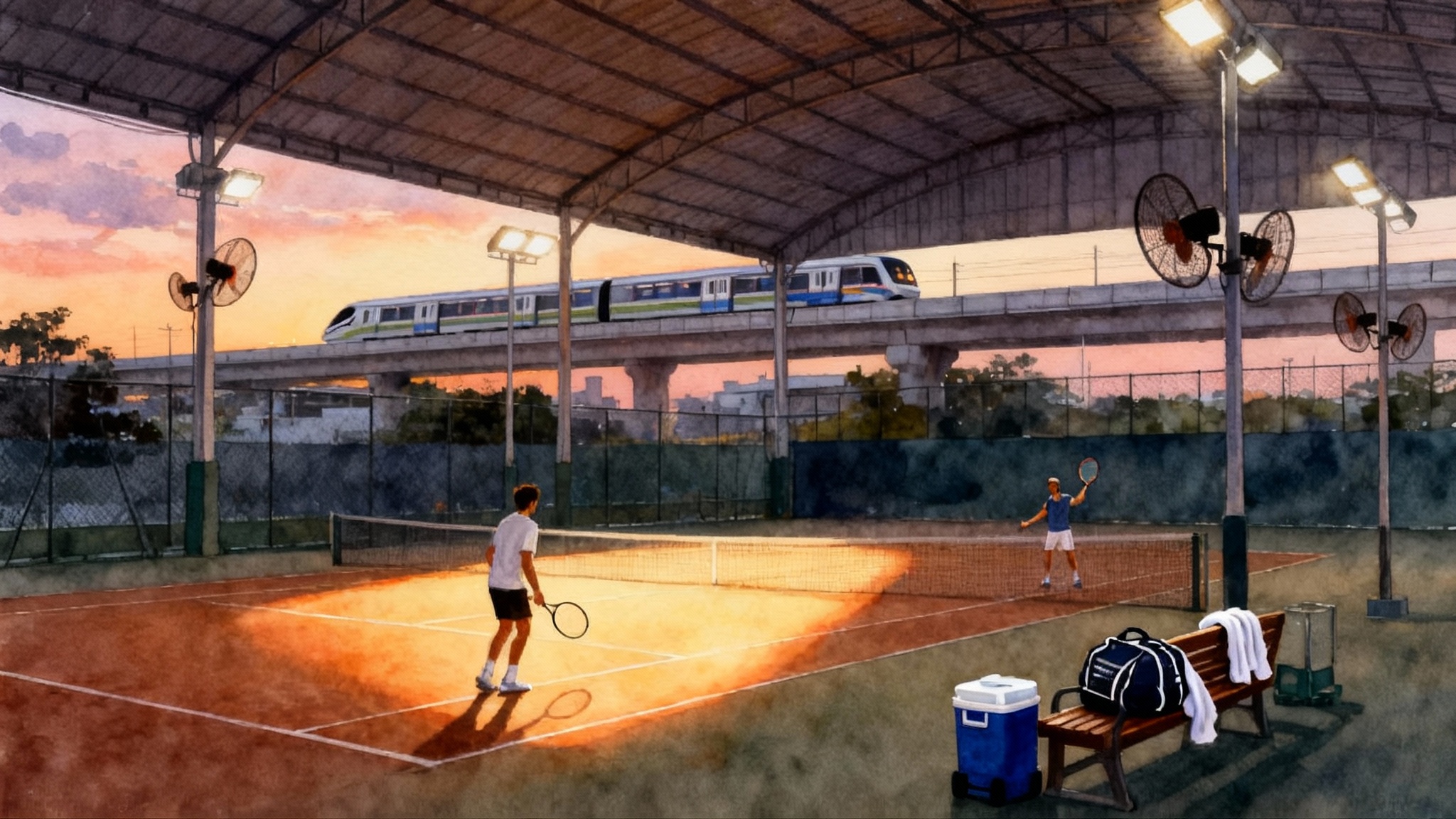
Why Bangkok from November to February works
Bangkok is hot year round, yet the cool and dry window from November to February is the closest the city gets to tennis-friendly weather. Rainfall drops, humidity eases, and mornings and evenings are reliably playable. Daytime peaks can still touch the low to mid 90s Fahrenheit, so the key is to ride the daily rhythm: strike early, hide at midday, return under lights. This window also lines up with Thailand’s busiest competition calendar, which means you can train and test yourself without long travel gaps.
If you are comparing winter bases, our Dubai winter tennis guide shows a Gulf option with a longer season and similar scheduling logic.
Think of the city like an outdoor gym that opens twice a day. The door swings wide from sunrise to roughly 9:30 a.m., then again from about 5:00 p.m. to 9:00 p.m. In between, you lift indoors, review video, re-string, hydrate, and nap. Accept that cadence and your block becomes sustainable rather than a willpower contest.
The daily schedule that beats the heat
- 5:45–6:15 a.m. Wake, light snack, electrolyte drink, sunscreen on
- 6:30–8:30 a.m. On-court slot one: priority on technical work and serve reps while courts are coolest
- 9:00–10:00 a.m. Mobility and strength: posterior chain work, core, shoulder care
- 10:30 a.m.–2:30 p.m. Recovery block: brunch, shade, nap, video review, stringing, massage or ice bath if needed
- 3:30–4:30 p.m. Optional skill micro-dose: 30–45 minutes on a covered court for patterns or returns
- 6:00–8:30 p.m. On-court slot two under lights: point play or match play, finish with serves and returns
- 9:00–9:30 p.m. Protein-forward dinner, light walk, sleep routine
Two principles make this work:
-
Start cool, finish fast: heavy technical reps in the morning when decision speed is fresh. Use the evening for pressure sets and tiebreakers.
-
Treat midday like altitude: reduce exposure, fuel, and prepare. A good nap is training in this climate, because it protects the evening session.
Covered courts plus outdoor heat adaptation
Bangkok has a healthy mix of covered hard courts and fully outdoor hard courts. Covered often means roofed, open-air courts with shade and fans, not sealed air-conditioning. Use that to your advantage. A productive split for week one is about 70 percent covered and 30 percent outdoor. By week two, shift toward 50:50, and in weeks three and four push your morning sessions outside when you can trust your hydration and pacing.
Practical tactics:
- Hydration plan: 500–700 milliliters of water with electrolytes in the hour before play, 250–300 milliliters every changeover, plus a small bottle of cold mix stashed at the back fence
- Cooling: two towels in a zip bag with ice, hat and light-colored shirt, switch grips if they get slick
- Pace: use a serve clock mentality for training blocks, 20–25 seconds between balls, 90 seconds on changeovers; build realistic match tolerance for humidity
- Data: note resting heart rate and body weight first thing each morning; if you are two pounds down day to day, push fluid and salt, and move the next session to a covered court
Your base camp: Troops Tennis Academy
For a non-boarding setup with a clear training structure, use Troops Tennis Academy Bangkok as your anchor. It runs private and group sessions, has the right early-morning and evening windows, and connects visiting players to sparring partners. Also see our Troops Tennis Academy profile for practical program details and logistics. Communicate your goals in advance, send a short video, and ask them to lock in coaches for the key slots of your first week. Use the Line app for quick confirmations and day-of changes, which is the local standard for bookings.
How to work with an academy as a traveler:
- Share your 2 to 4 week shell plan before you fly and get provisional time slots
- Book a hitting partner for at least two sessions per week so your coach can step back and observe
- Ask for match-play nights. Local players often want sets under lights midweek
- If you are a junior, request school-friendly times and a weekend tournament list. If you are an adult, ask for verified UTR-style level matches and a weekend trip plan to Hua Hin
Surfaces, venues, and booking etiquette
- Surfaces: most courts are acrylic hard. You will find a mix of outdoor and roof-covered courts. A few complexes beyond the city center also offer synthetic clay. Plan for hard-court footwear and bring a backup pair of shoes
- Booking: prime times are 6–8 a.m. and 6–9 p.m., so reserve those early. Many venues take payment on arrival in cash, some accept bank transfer or QR. Cancellations within 24 hours are frowned upon during high season
- Etiquette: arrive ten minutes early, do a short dynamic warm-up off court to start on time, respect the next booking, return ball carts, and avoid feeding lessons on courts that prohibit outside coaching
- Balls and stringing: balls are widely available at sports chains and pro shops. Bring two fresh cans per day for match play and one can for drills. Plan on one restring per 10–15 hours for polyester and every 20–25 hours for synthetic gut or multifilament
Two sample week plans you can use tomorrow
These are templates. Swap in covered courts as needed, and move the afternoon block earlier if sunset is before 6:00 p.m.
Week 1: Set your base
- Monday
- AM covered, 120 minutes: forehand and backhand tempo ladders, serve targets 40 makes, movement patterns with cones
- PM outdoor under lights, 90 minutes: baseline games to 21, transition work, 2 tiebreaks
- Tuesday
- AM outdoor, 90 minutes: serves plus first-ball patterns, 30 minutes return reps
- Midday, 45 minutes: mobility and scapular strength
- PM covered, 60 minutes: point construction with targets, no more than 80 percent intensity
- Wednesday
- AM covered, 120 minutes: video-taped technical session on one stroke priority
- PM optional, 60 minutes: doubles drills or light hit
- Thursday
- AM outdoor, 90 minutes: match play set, finish with serve plus one
- PM gym, 40 minutes: lower body strength, isometrics, core
- Friday
- AM covered, 90 minutes: live ball crosscourt to down-the-line patterns, approach and volley ladders
- PM outdoor, 90 minutes: practice set, super tiebreak
- Saturday
- Competition or match simulation: two sets with a local player, start at 5:30 p.m.
- Sunday
- Recovery: 30–45 minute light hit at sunrise, massage, 30 minute walk, early night
Week 2: Turn the screw
- Monday
- AM outdoor, 90 minutes: return games and pressure serves
- PM covered, 60 minutes: depth control with lanes and bonus points for short-middle-deep sequences
- Tuesday
- AM covered, 120 minutes: high-volume footwork, net rush patterns, 50 overheads
- PM outdoor, 90 minutes: two short sets, third set super tiebreak
- Wednesday
- AM outdoor, 75 minutes: serve plus two patterns, finishing to targets
- PM gym, 45 minutes: single-leg work, core, mobility
- Thursday
- AM covered, 90 minutes: crosscourt to down-the-line live ball, add approach and first volley
- PM optional 45 minutes: serves and returns only, then early dinner
- Friday
- AM outdoor, 90 minutes: full match set with new balls
- PM covered, 60 minutes: doubles or tie-break ladder
- Weekend
- Enter a local event or schedule two practice matches. If you want a change of scene, take the Friday midday bus or train to Hua Hin, check in, and play an evening set. Return Sunday night
Weeks 3–4: Extend or peak
If you extend to four weeks, increase outdoor morning volume on the priority stroke by 10–15 percent, keep at least two nights of match play, and add a mid-week travel-friendly recovery day. This is when short trips help your body absorb the work.
Competition pathway: Bangkok to Hua Hin
Thailand’s national body, the Lawn Tennis Association of Thailand, publishes a calendar of junior and adult events across Bangkok, Nonthaburi, and the seaside city of Hua Hin. The circuit includes weekend nationals, and at times International Tennis Federation events. Browse the LTAT events calendar to pick weekends that align with your block, then ask Troops to help with entries, warm-ups, and transport.
Why Hua Hin matters: it is three to four hours from Bangkok by car, is flat and breezy, and often hosts clusters of events. You can use a Hua Hin weekend as both competition and a mental reset. Aim for Friday evening light hitting, Saturday singles, Sunday doubles and mobility on the sand.
Side trips that speed recovery
- Chiang Mai: altitude relative to Bangkok is modest but the mornings feel crisp. Book an early court at a hotel or club and keep it light, then use the rest of the day for active recovery, markets, and sleep. Limit high-intensity work to a single, short sunrise hit
- Phuket: ocean air and sunrise courts help you reset. Schedule a 60–90 minute hit at dawn, then turn the rest of the day into a long mobility session in the pool and a beach walk. Night sessions are possible, but the point is to return to Bangkok fresher, not fitter
Costs you can plan for
These ranges reflect typical 2025 high-season prices in Bangkok. Bring cash for smaller venues, use cards or local transfers when offered, and expect a premium for roof-covered courts under lights.
- Court rental per hour
- Public or community hard courts: 150–300 Thai baht daytime, 250–400 Thai baht with lights
- Roof-covered hard courts: 300–600 Thai baht daytime, 400–800 Thai baht with lights
- Private schools and premium clubs when available to visitors: 300–500 Thai baht daytime, 500–1,000 Thai baht with lights
- Coaching and hitting
- Private lesson: 900–2,000 Thai baht per hour depending on coach seniority and venue
- Hitting partner: 400–900 Thai baht per hour
- Equipment
- New balls: 150–300 Thai baht per can
- Stringing: labor typically 300–600 Thai baht, plus 300–1,000 Thai baht for strings depending on brand
- Transport
- Bangkok Mass Transit System Skytrain and Mass Rapid Transit fares: usually 17–65 Thai baht per ride depending on distance
- Airport to city by ride-hailing or taxi: common totals 400–700 Thai baht including tolls
- Recovery and services
- Sports massage: 500–1,200 Thai baht for 60–90 minutes
- Same-day laundry near hotels and condos: 50–80 Thai baht per kilogram
- Accommodation
- Serviced studios near train lines: 25,000–45,000 Thai baht per month
- Mid-range hotels in Sukhumvit, Silom, or riverside areas: 1,500–3,000 Thai baht per night
Conversion tip: if you want United States dollar estimates, divide Thai baht by roughly 35–40 for a ballpark figure. Exchange rates move, so always check your card’s live rate.
Where to stay and how to move
- Neighborhoods that reduce travel friction: Phrom Phong to Bang Na along the Green Line, or anywhere within a ten to fifteen minute ride of your base courts. Being near a train line beats shaving a small amount off your room rate
- Getting around: the Skytrain and subway are clean and fast during rush hour. Motorbike taxis bridge the last mile. Ride-hailing is reliable for early mornings and late nights, but always allow buffer time for traffic
- Connectivity: buy a local prepaid SIM at the airport or any major 7-Eleven. Ten to twenty gigabytes for 15–30 days is usually inexpensive, and it makes booking, location sharing, and Line messaging easy
- Food and water: keep breakfast simple after the morning session, aim for rice, eggs, and fruit. Use a big bottle or collapsible jug so you can refill from filtered dispensers
Court-booking etiquette in Bangkok
- Message the venue or academy on Line with your full name, day, time, number of players, and whether you need lights
- To re-confirm, send a short message two hours before the session
- Arrive early, pay as directed, and clear the court three minutes before your slot ends so the next group starts on time
- Use non-marking tennis shoes, not running shoes. If a venue says no outside coaching, do not feed balls or film a lesson
- If you cancel inside 24 hours, offer to pay the court fee. It goes a long way here
Health, air, and safety
Bangkok air quality can wobble in January and February. If the Air Quality Index reads above 150, shift to covered courts, reduce long rallies, and increase rest intervals. Build a quiet, cool sleep environment, keep caffeine earlier in the day, and do a pre-bed mobility routine. The little daily things add up more than one heroic workout in this climate.
One practical itinerary
- Week 1 in Bangkok with Troops as your base: mostly covered courts, one or two outdoor mornings, one match night
- Weekend in Hua Hin: evening hit Friday, tournament or practice matches Saturday and Sunday, mobility on the beach
- Week 2 in Bangkok: ramp outdoor mornings to two or three, two match nights, one doubles night
- Optional extension to Week 3–4: sunrise light hits and cultural days in Chiang Mai or Phuket for recovery, then a final test match back in Bangkok
For a stateside alternative during the same period, see our Lake Nona winter training week.
The payoff
A well-built Bangkok block gives you two advantages at once. You learn to manage heat in a controlled way, and you stack a lot of quality reps because courts are plentiful and the city runs late. Anchor your plan with an academy that can secure courts and sparring, schedule around the sun, and keep your recovery as deliberate as your drills. Do that, and you will leave fitter, sharper, and better at closing tough sets when the air is heavy and the lights are bright.
